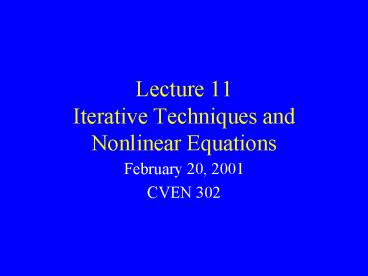Lecture 11 Iterative Techniques and Nonlinear Equations - PowerPoint PPT Presentation
1 / 29
Title:
Lecture 11 Iterative Techniques and Nonlinear Equations
Description:
... and will general help accelerate the convergence of the solution. ... SOR (Successive over Relaxation) uses the residuals to accelerate the convergence. ... – PowerPoint PPT presentation
Number of Views:225
Avg rating:3.0/5.0
Title: Lecture 11 Iterative Techniques and Nonlinear Equations
1
Lecture 11Iterative Techniques and Nonlinear
Equations
- February 20, 2001
- CVEN 302
2
Lectures Goals
- Correction to the Quintdiagonal terms
- Iterative Techniques - SOR method
- Nonlinear Systems of equations
- Newton method
- fixed point iterations
3
Band Solver
- The technique can be applied to higher order
banded matrices. - The quintdiagonal matrix has a similar algorithm.
4
Quintdiagonal Method
- The first phase starts with the first row of
coefficients scales the a and r coefficients. - The second phase solves for x values using the a
and r coefficients.
5
Correction Quintdiagonal Method
- There is a correction for the program, the bi
term will change and cause problems. - The b term must be modified before being used in
the updates of a, c and r terms.
6
Convergence Restrictions
- There are two conditions for the iterative method
to converge. - Necessary that 1 coefficient in each equation is
dominate. - The sufficient condition is that the diagonal is
dominate.
7
Successive over Relaxation
- The technique is a modification on the
Gauss-Seidel method with an additional parameter,
w, that may accelerate the convergence of the
iterations. - The weighting parameter, w, has two ranges 0 lt w
lt1, and 1lt w lt2. If w 1, then the problem is
the Gauss-Seidel technique.
8
SOR Method
- The SOR algorithm is defined as
- The difference is the weighting parameter, w.
9
The Weighting Parameter
- If the parameter, w is under 1, the residuals
will be under-relaxed. - If the parameter, w 1, the residuals are equal
to a Gauss-Seidel model. - If 1lt w lt 2 the residuals will be over-relaxed
and will general help accelerate the convergence
of the solution.
10
Example of SOR
- 4X1 2X2 2
- 2X1 10X2 4X3 6
- 4X2 5X3 5
- Solution (X1 , X2 , X3 ) (0.41379, 0.17241,
0.86206)
11
SOR Example
- Formulation of the SOR Algorithm
12
Effects of w Parameter
- Using the SOR program SOR(A,b,w,nmax,tol) with
nmax50 and tol 0.000001
13
Nonlinear Equations
- What is a nonlinear equation?
- Nonlinear equations are assumed to be those which
contain powers or products of the variables
and/or transcendental functions.
14
Nonlinear Equations
- What methods will we be using to handle nonlinear
equations? - Newtons method
- Direct iteration
- Minimum of a nonlinear function of several
variables.
15
Newtons Method
- By assuming that a sufficiently close approximate
solution x a1 and y b1 is known, the
equations can be expanded into Taylor series
about these points. By using Dx and Dy to
represent the changes in x and y, which need to
be made in successive cycles of approximation.
16
1-D Newtons Method
- The idea for the method comes from a Taylor
series expansion, where you know the function and
its first derivative. - f(xk1) f(xk) (xk1 - xk)fx (xk) ...
17
Newtons Method
- The goal of the calculations is to find a f(x)0,
so set f(xk1) 0 and rearrange the equation.
f x (xk) is the first derivative of f(x). - 0 f(xk) (xk1 - xk)f x(xk)
- xk1 _at_ xk - f(xk) / fx (xk)
18
Newton Method for 2-D Problem
- Using a two nonlinear functions, we would like to
find the intersection of the two. - The problem uses a Taylor series expansion to
calculate the next value if we have an initial
estimation.
19
Newton Method
20
Newtons Method
- The step size will vary with the function of the
derivatives. - The equation can be written in-terms of the
functions and their partial derivatives.
21
Newtons Method
- The Jacobian matrix is defined as the matrix of
partial derivatives of the functions.
22
Newtons Method
- The method is exactly the same as the 1-D method
except that the Jacobian matrix has more partial
derivatives to use to find the solution.
23
Example of Newtons Method
- 1.4X1 - X2 0.6
- X12 - 1.6X1 - X2 4.6
- Solution (X1 , X2 ) ( (-1,-2), (4,5) )
24
Newtons Example
- Jacobian matrix
- The functions are given.
25
Newton Example Program
- The program demoNewtonSys is a demonstration of
the Newton method for a two dimensional example.
26
Example of Newton
- 3X12 1.7X2 X32
1.7 - - 4X1 - X22 1.2X2 5X3
3.3 - - X12 2X1 2.7X2
-3X3 2.1
27
Summary
- SOR (Successive over Relaxation) uses the
residuals to accelerate the convergence.
28
Newton Method
29
Newton































